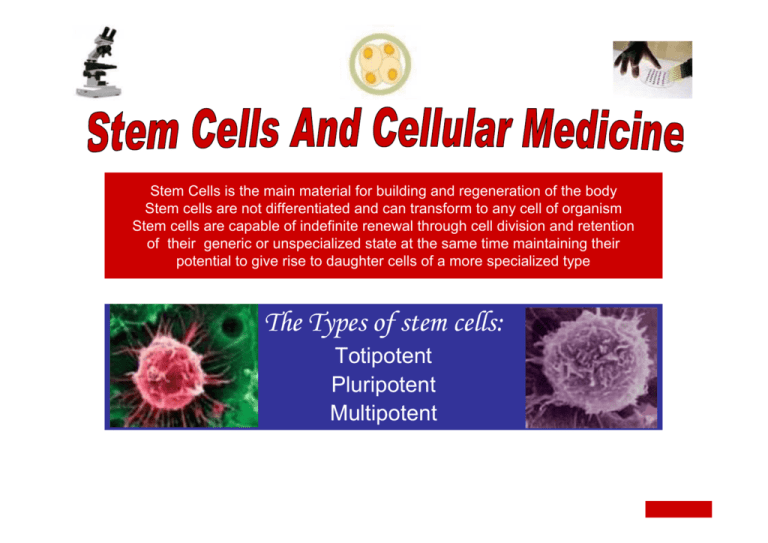
Stem Cells is the main material for building and regeneration of the body
Stem cells are not differentiated and can transform to any cell of organism
Stem cells are capable of indefinite renewal through cell division and retention
of their generic or unspecialized state at the same time maintaining their
potential to give rise to daughter cells of a more specialized type
The Types of stem cells:
Totipotent
Pluripotent
Multipotent
• Totipotent stem cells are known as the “
master”cells of the body because they have the capacity
to differentiate into the 216 specialized cell types that comprise the human body plus the placenta.
A fertilized egg is an example of a totipotent cell.
• Pluripotent stem cells are highly versatile cells and can give rise to any specialized cell type in
the body except those needed to develop a fetus. Embryonic stem cells are pluripotent.
• Multipotent stem cells can give rise to several specialized daughter cells but are limited to the
particular tissue, organ or physiological system of origin. For example, hematopoietic stem cells
can produce many types of blood cells in the circulatory system but cannot differentiate into a
brain cell. Hematopoietic stem cells are an example of adult stem cells and are multipotent. Stem
cells from umbilical cord blood are also multipotent based on evidence to date.
Sources of Totipotent, Pluripotent
and Multipotent Stem Cells
Sources of Stem cells
Fertilized Eggs’Stem cells (totipotent)
Embrionic Stem Cells (pluripotent)
Fetal Tissue Stem Cells ( pluripotent/multipotent )
Umbilical Blood Stem Cells ( pluripotent/multipotent )
Bone Marrow Mesenchimal SC ( multipotent )
Adult Stem Cells from Different Tissues (multipotent)
Embryonic Stem Cells
Pluripotent
Embryonic Stem Cells
Embryonic Germ Cells
Embryonic Carcinoma Cells
Differentiation of Human Body Cells from
Totipotent Stem Cells to Unipotent Tissue Cells
• Totipotent stem cells are the “
master”cells of the body because they
have the capacity to differentiate into the 216 specialized cell types
that comprise the human body plus the placenta.
• The only totipotent cells are the fertilized egg and the first 4 or so
cells produced by its cleavage.
In mammals, the expression totipotent stem cells is a misnomer —
totipotent cells cannot make more of themselves
Stem Cells From FertIized Egg
•
•
•
•
Embrionic pluripotent stem cells are derived
from the inner cell mass of blastocysts
created during artificial in vitro fertilization
of human eggs
• Pluripotent stem cells are highly
versatile cells and can give rise
• to any specialized cell type in the
body except those needed to
• develop a fetus.
Embrionic Germ Stem Cells
Embrionic Carcinoma Stem Cells
Embryonic Germ (EG) Cells are isolated from the
precursor to the gonads in aborted fetuses.
Embryonic Carcinoma (EC) Stem Cells can be isolated
from teratocarcinomas, a tumor that occasionally
occurs in a gonad of a fetus.
Fetus Stem Cells
•
Fetus Stem Cells are isolated from aborted
fetuses.
Fetus Stem Cell using has caused
ethical problems and debates
Aborted fetus material often is
contaminated and its using as
the source of stem cells rare
is safe
Cord blood, which traditionally has been
discarded, has emerged as an alternative
source of hematopoietic stem cells for the
treatment of leukemia, lymphoma and other
lethal blood disorders.
Umbilical cord blood from newborns is
a rich source of hematopoietic stem cells.
Adult Stem Cells
Adult Stem Cells
Bone Marrow Stem Cells
Neural Stem Cells
Skeletal Muscle and Heart Stem Cells
Skin Stem Cells
Fat Tissue Stem Cells
Peripheral Blood Stem Cells
Stem Cells of Cornea, Intestines, etc.
Adult Multipotent Somatic Stem Cells
• Adult ( Somatic ) stem cells are
unspecialized cells that are found in
different parts of the body and,
depending on the source tissue have
different properties.
The primary roles of adult stem cells
in a living organism are to maintain and
repair the tissue in which they are found.
Bone Marrow Stem Cells
• Hematopoietic stem cells that give rise to all
• blood and immune cells are today the most
• understood of the adult stem cells.
Hematopoietic stem cells from bone marrow
have been providing lifesaving cures for
leukemia and other blood disorders for over
40 years.
Bone Marrow Stem Cells
• Hematopoietic stem cells are primarily found
• in the bone marrow but have also been found
• in the peripheral blood in very low numbers.
Compared to adult stem cells from other tissues,
hematopoietic stem cells are relatively easy to obtain.
Mesenchymal stem cells are also found in the bone marrow
Mesenchymal stem cells are a mixed population of cells that
can form fat cells, bone, cartilage and ligaments, muscle cells,
skin cells and nerve cells.
Bone Marrow Stem Cells
• Adult stem cells are multipotent, meaning that
• they appear to be limited in the cell types that
• they can produce. But adult stem cells may have
• more plasticity than originally thought. Stem cell
• plasticity is the ability of a stem cell from one
• tissue to generate the specialized cell type(s)
• of another tissue. For example, bone marrow
• stromal cells are known to give rise to bone
• cells, cartilage cells, fat cells and other types
• of connective tissue (which is expected), but they
• may also differentiate into cardiac muscle cells
• and skeletal muscle cells (this was not initially
• thought possible).
Adult Stem Cells
There are a very small number of stem cells
in each tissue. Stem cells are thought to
reside in a specific area of each tissue where
they may remain quiescent (non-dividing)
for many years until they are activated by
disease or tissue injury.
A potential advantage of using stem cells from
an adult is that the patient's own cells could be
expanded in culture and then reintroduced into
the patient. The use of the patient's own adult
stem cells would mean that the cells would not
be rejected by the immune system.
Adult Stem Cells Isolation And Cultivation
•
•
•
•
•
•
•
•
Large numbers of embryonic stem cells can be
relatively easily grown in culture, while adult
stem cells are rare in mature tissues and
Methods for expanding their numbers in cell
Culture is still hard and complicated . This is
An important distinction, as large numbers of
cells are needed for stem cell replacement
therapies.
Adult Stem Cell Plasticity
•
•
•
•
•
•
•
•
•
•
•
•
Adult stem cell plasticity and transdifferentiation.
Certain adult stem cell types are pluripotent.
This ability to differentiate into multiple cell types
is called plasticity or transdifferentiation.
Hematopoietic stem cells may differentiate into:
three major types of brain cells ( neurons,
oligodendrocytes, and astrocytes); skeletal muscle
cells; cardiac muscle cells; and liver cells.
Bone marrow stromal cells may differentiate into:
cardiac muscle cells and skeletal muscle cells.
Brain stem cells may differentiate into: blood
cells and skeletal muscle cells.
Diseases Treated With Stem Cells
•
•
•
•
•
•
•
•
•
•
•
•
•
•
•
•
Alzheimer's
Autism
Autoimmune diseases
Anemias
Bone and cartilage deformities
Burns
Cancer (brain, breast, ovarian,
etc.)
Cerebral palsy
Corneal scaring
Crone's disease
Diabetes
Heart disease
Immunodeficiencies
Repair of cardiac tissue after MI
Leukemias
Lymphomas
Melanoma
Multiple sclerosis
Multiple myelomas
Muscular dystrophy
Neural blastoma
Osteoarthritis
Paralysis
Parkinson's Disease
Rheumatoid arthritis
Scleroderma
Scleromixadema
Spinal chord damage
Stroke
Systemic lupus
Tendonitis
Stem Cells In
Neurodegenerative Diseases
•
•
•
•
•
•
Stem cell therapy is the most
promising and effective cure
of neurological diseases. In
some neurodegenerative
diseases stem cell therapy is
8-15 times more effective
than
• standard therapy, in others
• stem cell therapy is the only
• treatment and hope for
patients
Stem Cells In Neurodegenerative
Diseases
•
•
•
•
•
•
•
•
•
•
•
•
•
•
•
Stem cells of different origin (embryonic,
umbilical cord blood, bone marrow, adult
stem cells, etc.) can participate in repair
of damage after stroke. Stem cells have a
great potential in Parkinson disease,
rescuing and preventing the degeneration
of endogenous dopaminergic neurons.
Stem cells provide remyelinization in
multiple sclerosis and amyotrophic lateral
sclerosis and may be the best choice for
treatment of these diseases. Stem cells are
very promising for the treatment of
Alzheimer’
s diseases, head trauma, brain
tissue injuries of different kind, in other
neurological conditions and pathologies.
Stem Cells In Neurodegenerative
Diseases
•
•
•
•
•
In neurodegenerative diseases
for by-passing blood-brain
barrier stem cells may be injected
sub thecal into spinal fluid or
directly into the brain tissue.
Stem Cells In Heart Diseases
•
•
•
•
•
•
•
•
•
•
Stem cells have been identified as
Integrating into cardiac tissue,
forming cardiomyocytes and / or
cardiac blood vessels, regenerating
infarcted heart tissue, and improving
cardiac function. All kinds of stem
cells injected into old animals seems
capable of restoring cardiac function,
apparently through increased activity
for cardiac blood vessel formation.
Stem Cells In Heart Diseases
The evidence has led numerous
groups to use stem cells of
different origin in treatment of
patients with damaged cardiac
tissue. Results from these clinical
trials indicate that the stem cells,
including cells from the patients
themselves, can regenerate damaged
cardiac tissue and improve cardiac
performance in humans. In terms of
restoring angiogenesis and improving
blood circulation, results in patients
are not limited to the heart. Stem
cells from the patients themselves
can improve blood circulation in
gangrenous limbs, in many cases
obviating the need for amputation.
Fat Tissue Stem Cells
• Adipose tissue, also known as
fat tissue, is one of the most
recently discovered sources
of adult stem cells. In addition
to stem cells, there lies within
adipose tissue a defined
population of cell types that
are also major contributors to
healing , referred to as
'regenerative cells.' Together,
these stem and regenerative
cells represent tremendous
opportunities for treating
cardiovascular disease, spine
and orthopedic disorders,
vascular conditions,
reconstructive surgery as well
as a variety of other areas of
medicine.
Fat Is Rich Stem Cell Source
• Rich Cell Source
• Adipose tissue is the richest
and most accessible known
source in the human body of
adult stem cells. By
comparison, it contains a
hundred times more stem
cells in the same amount of
bone marrow, a commonlyused source for stem cells.
• Adipose tissue is the
richest known source for
stem cells
•
Fat Stem Cell Action
• Adipose tissue contains
numerous types of
regenerative cells. These
include adult stem cells,
vascular endothelial cells,
vascular smooth muscle cells
and other cell types.
• These cells collectively
contribute to healing and
repair through a variety of
mechanisms that involve
promoting blood vessel
growth in an area of injury,
keeping alive injured cells that
are at risk of dying (antiapoptosis), and the ability to
differentiate into several
tissue types, such as bone,
cartilage, fat, skeletal muscle,
smooth muscle and cardiac
muscle.
Fat Stem Cells Separation And Cultivation
• There are lots of different
separation techniques for
isolation of fat stem cells:
• Acoustophoresis,
• Dielectrophoresis,
• Density Gradient
Centrifugation, etc.
• There are also many
techniques and
• protocols for fat stem cell
cultivation in media.
Confidential
American-Armenian Health
Development Center
Innovative Stem Cell therapies
in USA and Armenia
All right reserved by Green Medical
Systems Co.,Ltd.
American –Armenian
Health Development Center
Collaboration between Armenia and USA in the field of Stem Cell therapy
Address: Andranik 3
Yerevan, Armenia
375014








